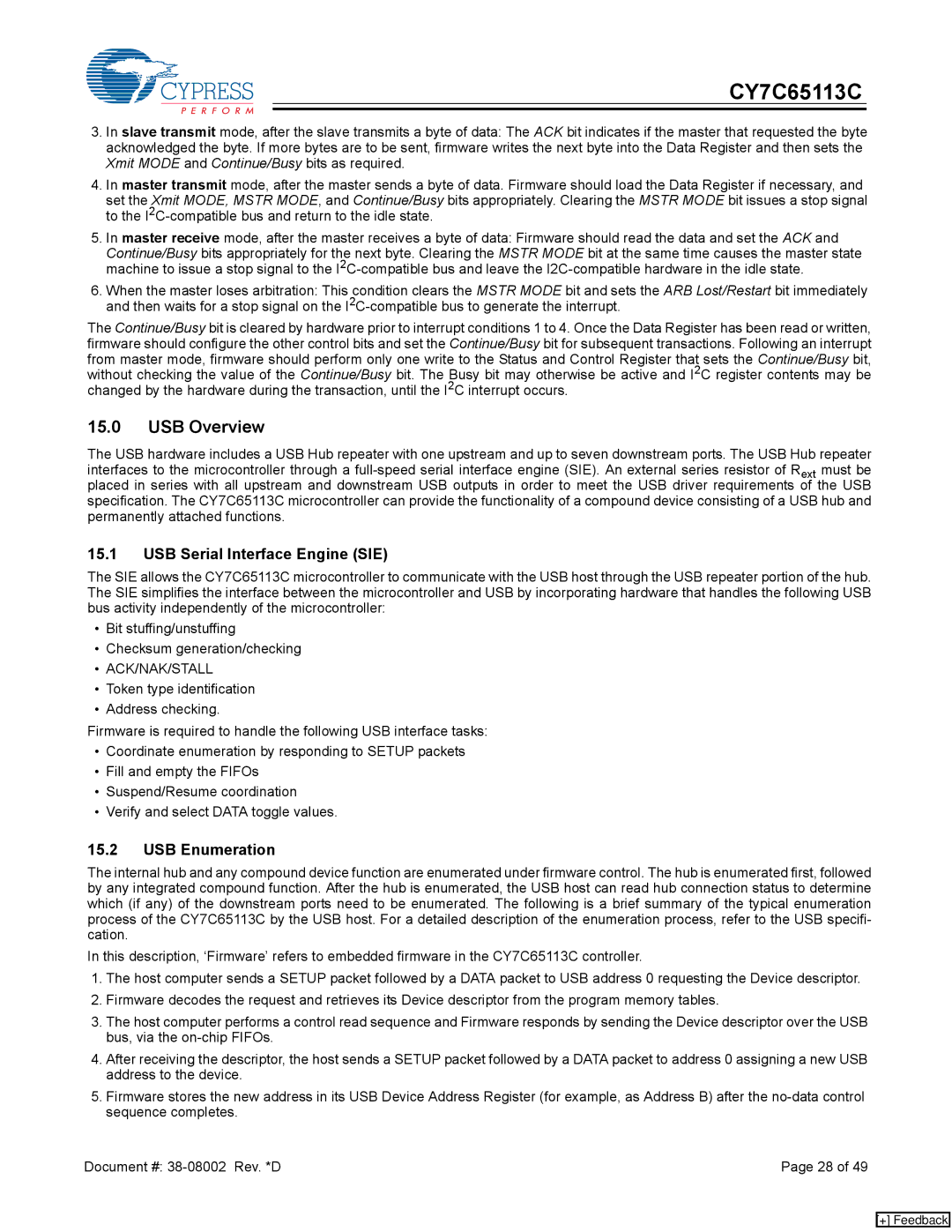
CY7C65113C
3.In slave transmit mode, after the slave transmits a byte of data: The ACK bit indicates if the master that requested the byte acknowledged the byte. If more bytes are to be sent, firmware writes the next byte into the Data Register and then sets the Xmit MODE and Continue/Busy bits as required.
4.In master transmit mode, after the master sends a byte of data. Firmware should load the Data Register if necessary, and set the Xmit MODE, MSTR MODE, and Continue/Busy bits appropriately. Clearing the MSTR MODE bit issues a stop signal to the
5.In master receive mode, after the master receives a byte of data: Firmware should read the data and set the ACK and Continue/Busy bits appropriately for the next byte. Clearing the MSTR MODE bit at the same time causes the master state machine to issue a stop signal to the
6.When the master loses arbitration: This condition clears the MSTR MODE bit and sets the ARB Lost/Restart bit immediately and then waits for a stop signal on the
The Continue/Busy bit is cleared by hardware prior to interrupt conditions 1 to 4. Once the Data Register has been read or written, firmware should configure the other control bits and set the Continue/Busy bit for subsequent transactions. Following an interrupt from master mode, firmware should perform only one write to the Status and Control Register that sets the Continue/Busy bit, without checking the value of the Continue/Busy bit. The Busy bit may otherwise be active and I2C register contents may be changed by the hardware during the transaction, until the I2C interrupt occurs.
15.0USB Overview
The USB hardware includes a USB Hub repeater with one upstream and up to seven downstream ports. The USB Hub repeater interfaces to the microcontroller through a
15.1USB Serial Interface Engine (SIE)
The SIE allows the CY7C65113C microcontroller to communicate with the USB host through the USB repeater portion of the hub. The SIE simplifies the interface between the microcontroller and USB by incorporating hardware that handles the following USB bus activity independently of the microcontroller:
•Bit stuffing/unstuffing
•Checksum generation/checking
•ACK/NAK/STALL
•Token type identification
•Address checking.
Firmware is required to handle the following USB interface tasks:
•Coordinate enumeration by responding to SETUP packets
•Fill and empty the FIFOs
•Suspend/Resume coordination
•Verify and select DATA toggle values.
15.2USB Enumeration
The internal hub and any compound device function are enumerated under firmware control. The hub is enumerated first, followed by any integrated compound function. After the hub is enumerated, the USB host can read hub connection status to determine which (if any) of the downstream ports need to be enumerated. The following is a brief summary of the typical enumeration process of the CY7C65113C by the USB host. For a detailed description of the enumeration process, refer to the USB specifi- cation.
In this description, ‘Firmware’ refers to embedded firmware in the CY7C65113C controller.
1.The host computer sends a SETUP packet followed by a DATA packet to USB address 0 requesting the Device descriptor.
2.Firmware decodes the request and retrieves its Device descriptor from the program memory tables.
3.The host computer performs a control read sequence and Firmware responds by sending the Device descriptor over the USB bus, via the
4.After receiving the descriptor, the host sends a SETUP packet followed by a DATA packet to address 0 assigning a new USB address to the device.
5.Firmware stores the new address in its USB Device Address Register (for example, as Address B) after the
Document #: | Page 28 of 49 |
[+] Feedback
